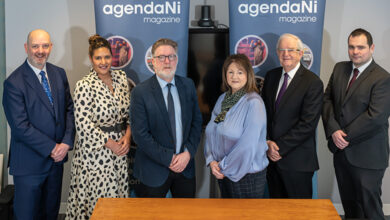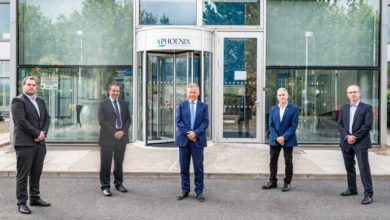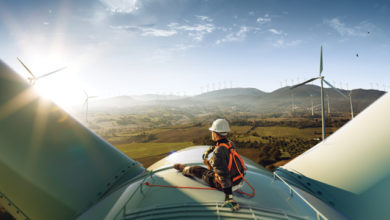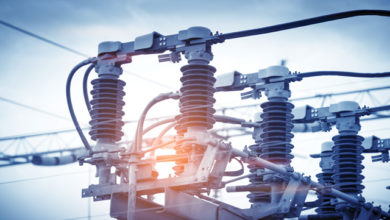Decarbonising the Northern Ireland power system
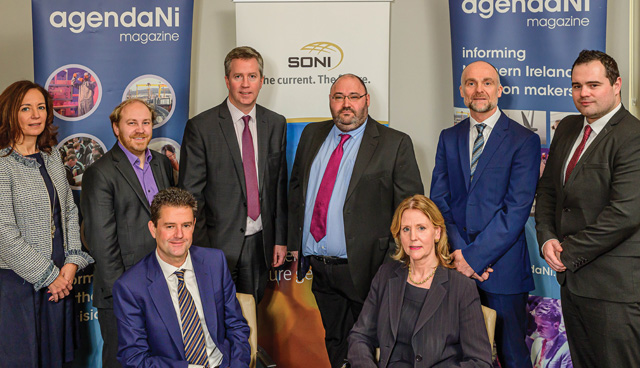
SONI hosted a round table discussion with key stakeholders from the energy sector about transforming the power system for future generations.
Climate change is an existential issue, what role can the Northern Ireland power system play in arresting this threat?
Jo Aston
The power system has a pivotal role in reducing carbon dioxide levels and ultimately reducing climate change. Northern Ireland’s track record is good but the achievement of reaching 40 per cent of power from renewable sources before 2020 now looks like low hanging fruit when you consider the challenges ahead. The ultimate goal is to reach 100 per cent and within SONI we see our responsibility being to ensure we have a power system ready for the radical changes that need to occur in the energy system. Transformation cannot be solely focussed on the grid or the market, it must take a holistic approach. In our strategy, launched in October, we set out a primary goal to lead the electricity sector on sustainability and decarbonisation. Fundamental to this will be working in partnerships across the sector and education of and engagement with communities.
Kevin Shiels
Arresting the threat starts at the overarching policy level. We’ve seen the UK’s move to declare a climate emergency and that has influenced policy for net zero carbon by 2050. We have a 30-year window to make radical change to our energy sector in Northern Ireland and in order to do that there must be an energy revolution. No one piece of the energy jigsaw will deliver the necessary change, instead, it’s going to require an integrated whole-of-system approach. Changes to the generation mix, the grid, the consumer role and energy supply business models will contribute, and all require market framework and regulatory rule alteration. We need to enable the change and protect the consumer. There is also the role of data. System data and consumer data will be optimised for maximum benefits on all sides. It’s a huge challenge but there are huge opportunities as well.
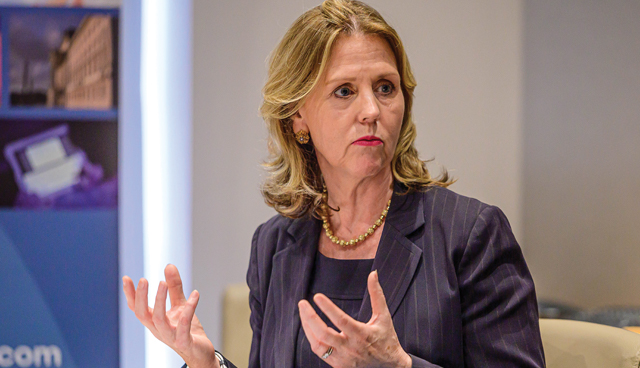
Richard Rodgers
Power is one of the three key segments of decarbonisation, along with heat and transport. However, power is also a fundamental enabler of ambitions to decarbonise these other segments through electrification and to getting a fully decarbonised energy mix by 2050, when the system will have to be able to take 100 per cent renewables. That’s a massive challenge considering that 10 years ago there were doubts we could ever get to 20 per cent and a credit to the engineering solutions that we are on our way towards 75 per cent. We have to find solutions that will allow energy to be cost-competitive for industry and the consumer. However, significant investment will be needed and we need to work out how these costs will be paid.
Sam McCloskey
Research, development and innovation all have a huge part to play in addressing some of these issues. I was probably one of the doubters in Richard’s scenario, eight years ago when I started out in this post, thinking it would be very difficult to get to those targets set out in 2010. However, progress has been made and I think in no small part with thanks to partnerships between industry and academia in creating opportunities and solutions. There is an acknowledgement of a joining together of the decarbonisation agenda and the energy agenda since the IPCC Climate Change Report and transformation is going to need a holistic approach.
Paul Stapleton
The power system has a huge role to play. Power now counts for less than 17 per cent of Northern Ireland’s carbon emissions but when you look at the potential of clean, green electricity to displace fossil fuels in heat and transport, it could be the solution for something approaching 60 per cent of carbon emissions. However, it won’t be the entire solution and I think all aspects of the system will need to come together. As the custodian of the electricity network we have a huge role to play in that as an enabler. Partnerships will need to evolve into a model that will enable the transition. I’m optimistic but I think it will need to and can be done much sooner than 2050.
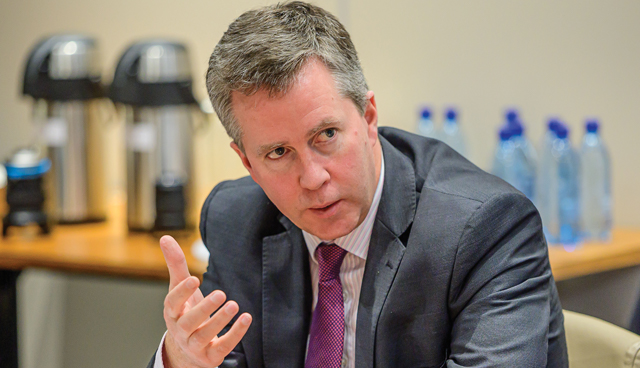
Paulino García
Decarbonisation is not just about energy but about lifestyle and business choices and so we need consumers and businesses to be onboard for the journey to be successful. It’s important also that the energy transition is tailored to be Northern Ireland specific. Northern Ireland consumers are less resilient financially than in GB, for example our weekly disposable income is some £100 less than the GB average and so affordability will be a big part of whether the transition is bought in to. Another key factor is trust. We’re asking people to invest in a renewable future and so information must be widely available, clear and robust. If done right, it presents an opportunity for consumers and the energy industry to pull in the same direction.
Steven Agnew
Baringa’s The Wind Dividend report shows that Northern Ireland has already saved nine million tonnes of carbon as a result of a greater focus on renewables. Going forward, electricity has an even bigger role to play as we adopt more electrified heat and transport, so I think there are plenty of opportunities. The 40 per cent was a low hanging fruit given that power was the easiest sector to decarbonise and we’re at a stage now where it will take an energy revolution. However, there is a consensus to do that. I’m hopeful that the Department for the Economy’s (DfE) forthcoming energy strategy will offer a stretch target that will allow other policy leavers and investment to fall in behind.
What role does energy policy have in informing the power system transformation?
Richard Rodgers
Global government policy, if pointed in the right direction could see us end our love affair with fossil fuels. To date that hasn’t happened but I think we are no longer talking about whether decarbonisation will happen, it’s about how decarbonisation will happen. It’s important that Northern Ireland policy plays its part as a global citizen. One challenge we face is that we have no legislation to support the development of renewables. RHI has shown us that bad policy can be devastating and given the complexity of the revolution required for our energy sources, we’ve got to get it right. Support mechanisms need to be established to offer investors certainty and policy must be over a sustained, longer-term period. We’ve found that a start/stop approach means a loss of capacity, expertise and skills in the sector. However, done well, policy can be a major stimulator of the economy.
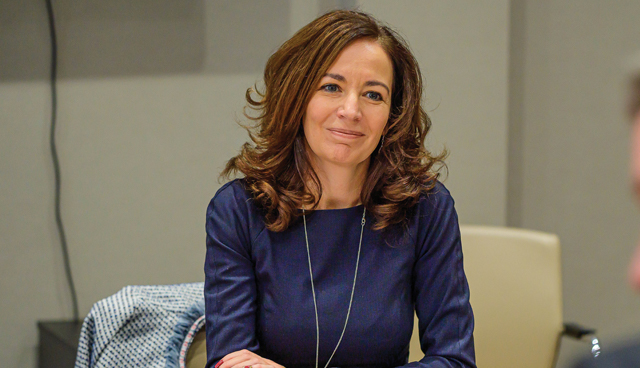
Steven Agnew
There are three core strands of policy development that must be addressed to meet even the 70 per cent target set out by the Republic of Ireland. The first is market mechanisms and the need for a support system. This might be a price floor to offer security. The second is the need for a consensus approach to the necessary grid infrastructure in policy and funding. The third is planning, all of these ambitions could stop if developers don’t have access to the grid and can’t get the permissions. As councils prepare their development plans, a regressive LDP could kill off any policy ambitions being set currently. So, we need all aspects of government and public policy pushing in the one direction.
Jo Aston
The North South Interconnector has been in planning for over a decade now and while we have these ambitions for levels of renewables in Northern Ireland, our market without the North South Interconnector is very constrained. That’s not appealing to investors and it’s costing the consumer money, of the order of £20 million/annum. We have to find a way to get strategic infrastructure built and built quickly, with meaningful engagement and consultation. This is what is needed if we are realistic about achieving net zero carbon by 2050.
On policy, we have a massive challenge around alignment across all government departments. SONI are currently working with NIE Networks to analyse what decarbonisation actually means for the electricity system, as we seek to present a tangible vision to inform policy direction. We have modelled a number of credible future energy scenarios, in which we envisage heat and transport looking to electricity as a reliable source of renewable energy. It’s clear that policies will need to be aligned and must work in tandem if SONI is to plan and meet increasing demand from renewable sources. Considering the timeframe, it is important that we develop a roadmap which enables us to monitor progress.
Paul Stapleton
Policy is the essential starting point of the energy transformation. It won’t happen without clear direction and we’ve seen from Ireland and GB how effective clarity of policy can be in terms of momentum. The huge amount of investment needed for the sector will require an appropriate policy framework for both regulated and market investment. Consumers will need clarity from policy too, to help them change behaviours, with an appropriate balance of incentives and dis-incentives.
Kevin Shiels
Other countries who have embarked on successful energy transitions have benefited from centrally-led coordination and been driven by a strong policy framework. Importantly, DfE have picked up the baton in developing a new framework for Northern Ireland and it is taking a cross-departmental approach. Looking at the fundamental changes required, they will change for example the outputs and targets that we are setting from our grids. Clarity of goal is critical to enable the regulatory frameworks that industry, consumers and investors need to deliver on policy goals. Outside of that, new consumer frameworks will be required to bring the consumer along and incentivise behavioural changes.
Sam McCloskey
Policy supporting innovation can contribute to the decarbonisation pathway. Other parts of GB have recognised this, particularly on the ocean energy side and the Marine Energy Council is lobbying government for an Innovation Power Purchase Agreement or Contract for Difference. Remember, we have a 200MW of potential tidal energy site off the north coast and potentially 600MW of offshore wind. To date CASE has supported 25 sustainable energy R&D projects through the Invest NI competence centre programme, however, we are one of the only sources of collaborative R&D funding in this area in Northern Ireland. The tidal energy sector is still some way off being economically viable but further R&D and policy to support innovation in these areas could make a real difference.
Paulino García
It’s worth reflecting on the success in terms of meeting the 40 per cent target which, even a couple of years ago, wasn’t a foregone conclusion. Such success builds momentum and can inspire consumers to embrace the changes needed to meet net zero carbon. The new energy strategy can have the same transformational impact on our energy systems. It is important also that it provides strong signals that the interests of consumers must be at the centre of decarbonisation policies supported by their statutory body.
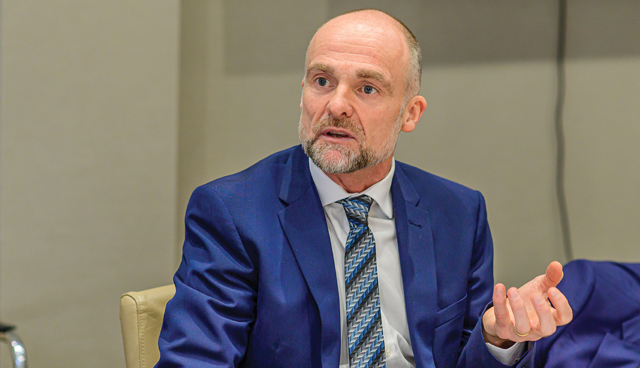
We have a clear direction of travel in terms of destination – but when it comes to transforming the power system – what will it take to actually get there?
Sam McCloskey
It’s an unknown entity. We have an evidence base, a thriving onshore wind sector, lots of data and an end goal but we’re currently in that grey area around deployment options. The best option is a holistic outcome including many factors like the empowered prosumer, community energy and access to the grid. We don’t quite know the sweet spot yet but there is recognition that it is likely to involve a range of different technologies. Costs are constantly being reduced in what we now term ‘traditional type’ renewable technology, such as offshore wind (reducing from £160+ to less than £40 per MW/hr now), and we need to find the appropriate mix for Northern Ireland.
Kevin Shiels
Innovation is crucial over the next five to 10 years and traditionally, regulators can struggle to incentivise and ‘drive’ innovation. We tend to create frameworks for steady state industries that may not foster and encourage enough innovation. I’m aware of lots of pilots and projects underway in Northern Ireland but I don’t think we have a particularly good model for learning from or upscaling those market-wide. We have to get better at that because if you look at other parts of these islands, their innovations tend to be better linked to policy and frameworks than what we have. Also, clarity on the policy framework around energy efficiency is going to be key.
Richard Rodgers
The challenge is having the vision to see that some cost now might be better than much larger costs down the road because we haven’t tested or piloted ideas. I also understand that it’s difficult for regulators who want to keep the cost to the consumer down as much as possible. However, we must create the space for innovation.
Paul Stapleton
I agree that the current regulatory framework maybe isn’t innovation friendly but in fairness to the Utility Regulator, in our last price control, there was some provision for innovation and some flexibility built in. Admittingly, given the context change in the last three years there probably wasn’t enough provision made. There is a challenge for the regulatory framework to be more agile and responsive but that has to come from the policy and regulatory mandate.
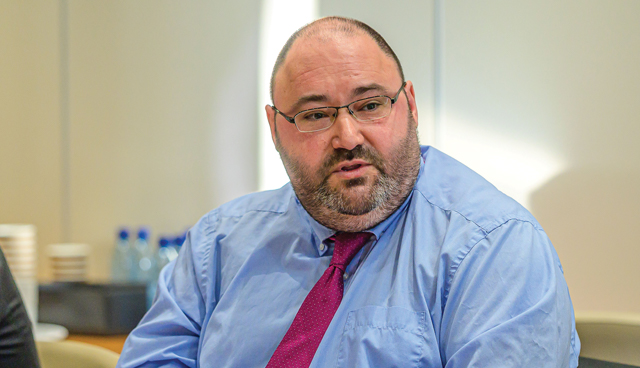
Steven Agnew
We focus on the long-term price and the wind dividend report outlines a clear benefit to consumers as a result of increased generation. Grid investments in the past have ultimately brought down the cost for the consumer and there is no reason to believe that this trend wouldn’t continue.
Jo Aston
The reformation of the SEM brought about a more liberalised, competitive market; utilising real time trading and auctions which provide a route to market, with the cheapest bidder who can deliver winning. It is about competition and consumer benefits. We have to continue to create the environment and the incentives to attract investment, to enable new technology to be competitive and to get the right answer for the consumer. Our strategy, in analysing scenarios for 70 per cent renewables by 2030, identified that we probably need to double the levels of renewables on the system that we have today. We have identified around £500 million of investment needed in the grid over the next decade and we need the North South Interconnector. We’ve also challenged ourselves to get from the 65 per cent of wind penetration on the system at any one time currently, to 95 per cent and this is being done in the context of a major shift from traditionally a few very large generating units feeding in, to potentially hundreds of smaller ones, while still providing security of supply, reliability and cost-effectiveness. A further challenge is around incentives and education. If we want to transform the power system we need incentives for the market but we also need incentives for consumers to change. The answer has to be the right one in terms of affordability.
Paulino García
We are now in a whole new era in terms of prosumers and consumer vulnerability compared to the start of the current energy strategy. We have to get the policy and the engagement right so that no consumer is left behind in the energy transition. I think the consumer principles, which have been in place from the 1960s, should be considered when developing the policies needed to deliver zero carbon.
Paul Stapleton
There are three key ingredients from outside the narrow confines of the energy sector. The first is consumer and community engagement. The second is the attraction of external capital. The third is skills. A skills shortage could be a bottleneck if not addressed.
How do we engage various user groups through the transition?
Paulino García
Traditional engagement through the likes of focus groups or surveys is likely to be insufficient to inform how to overcome the challenges ahead. A strong consumer voice is required, as well as new thinking around how we can have a meaningful and co-coordinated approach to engagement, ensuring the reach is broad and it has an impact in the design of the energy transition.
Kevin Shiels
We are currently scoping out a project called ‘Consumers in Transition’ seeking to identify the consumer-facing aspects of transition and how they will need to be built into a regulatory framework both in terms of empowerment and protection. On a specific example, a block of flats in London recently became the UK’s first local energy market offering flexibility services to the network and a peer-to-peer market for renewables and storage. That type of innovation is the transition actually happening and clearly the decentralised world of energy is a good area for the piloting of emerging renewable technologies.
Jo Aston
The engaged customer is an exciting prospect. In our strategy we identified partnership as a supporting goal because we understand that success is not just electricity success but across the board and that will require engagement for better outcomes. Within SONI and NIE Networks, you have two types of challenges. The first is building the infrastructure and the second is about how you consult, engage and bring people onboard. Communities have got to see a tangible benefit from infrastructure going up in their area and education is important, it is about empowering communities and helping them to view their energy in a different way. I look at the likes of Airbnb and Uber and see how that digitalisation and transfer of information has empowered customers to change their habits. With our data collection, there is opportunity here within energy.
Richard Rodgers
There is no silver bullet. However, as a small region we have great opportunity. We’re not going to invent all the solutions but we can trial them and bring our own innovation to them. In government, we need to find a way to encourage this through policy.
Sam McCloskey
Jo’s example of Airbnb and Uber are good examples of diversification in organisations that have capitalised on new opportunities. Industry and business are key sectors we need to engage with as we go through the transition. There are big opportunities for organisations in the form of lower costs, greater efficiencies and diversification potential. Trade associations can be the enablers of business clusters within this engagement area.
In your view, how does the power system future look to 2030 and beyond?
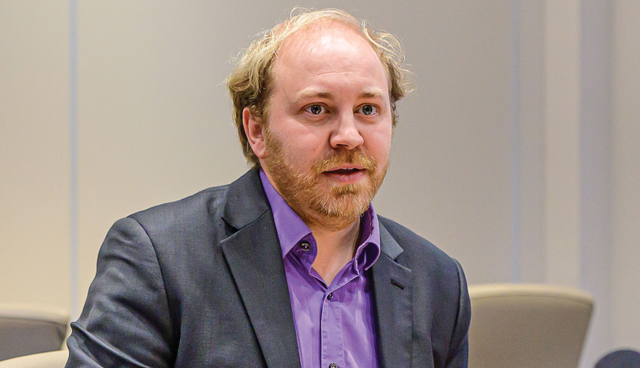
Steven Agnew
To hit net zero by 2050 we actually need to fully decarbonise the power sector by 2040. So, by 2030 we need to be well advanced in that journey and at least at 70 per cent renewable electricity. In terms of technology, I think onshore wind will remain dominant over the next decade but it will be a policy failure if we have not advanced projects in tidal, off shore wind and solar. We need diversity of technology and we need significant improvements in energy efficiency.
Paulino García
I envisage us delivering on the target. We have the momentum, the commitment and the knowledge and expertise within the industry to do that. However, this will require stronger partnerships and greater levels of cooperation with Northern Ireland consumers and businesses to deliver a system that is more consumer-centric.
Paul Stapleton
The system will be more renewables, from a greater mix, and so carbon intensity should have reduced significantly by 2030. That clean energy should be being used to reduce fossil fuels, where appropriate, in heat and transport. This will require investment in infrastructure and hopefully we will have had a mature debate as a society about infrastructure acceptability.
Sam McCloskey
To use terminology from the Matrix Sustainable Energy Horizon Panel Report, I envisage an intelligent energy system. The report focussed on technology and the connection of renewables to the grid but we can go further and expect an intelligent system for all stakeholders and across all energy vectors.
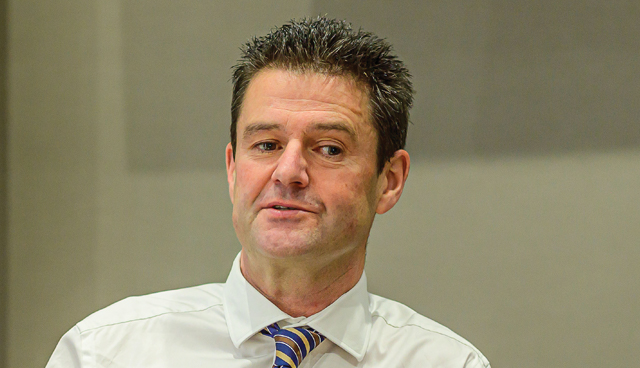
Richard Rodgers
The electrification of transport and heat, to one degree or another, will increase the demand for electricity and shape the future system. Progress on renewable power itself has all but stopped and needs to be given new impetus otherwise we will fall behind our neighbours. These are all big tasks and in reaching for them we need to ensure that the consumer remains at the heart of decisions and that any changes are affordable for both business and domestic consumers.
Kevin Shiels
The system should look very different, driven by large proportion of renewable generation. Market mechanisms should allow for the most efficient renewables to come on stream. The extent to which the power system/grids have to grow will depend on progress around energy efficiency and key policy areas around the electrification of heat and transport. In addition, I suspect we will see a much more interactive and flexible system. This will all cost money and we will have to do it through an optimal least-cost model for Northern Ireland.
Jo Aston
In SONI’s tomorrow’s energy scenarios, getting to 70 per cent by 2030 will require 250,000 EVs on Northern Ireland’s roads, 130,000 households transferring to heat pumps and a large-scale embracement of energy efficiency. It foresees offshore generation on the network, while still needing some large-scale generation from gas for security of supply and reliability. In terms of the individual, most of us will drive an EV; 68 per cent of households currently on oil heating will switch and we will have enabled community energy schemes. To achieve all of this is quite a challenge; we all need to be engaged.
The Participants
Steven Agnew
Steven is the newly appointed Head of NIRIG and former leader of the Green Party in Northern Ireland. He served as MLA for North Down from 2011 to 2019 and sat for five years on the Enterprise, Trade and Investment Committee which scrutinised energy policy. He was also the architect of the Children’s Services Co-operation Act.
Jo Aston
Jo is Managing Director of SONI, having been appointed in early 2019. She joined SONI from the Utility Regulator, where she was Director of Wholesale Energy Markets. Jo is a Chartered Civil Engineer. She is an active member of the Institution of Civil Engineers and was the Northern Ireland Chairperson for 2012-2013. She has worked for both the private and public sector, predominantly in the utility sector.
Paulino García
Paulino joined The Consumer Council in 2006 and is the current Head of Energy Policy. Paulino has extensive experience on energy and consumer issues, having been an integral part of The Consumer Council’s Energy Policy team since 2010. Previously, he was part of the Consumer Protection team in a complaints handling and investigation role.
Sam McCloskey
Sam is Director of the Centre for Advanced Sustainable Energy (CASE). Sam joined CASE in 2011 following an 18-year career in consultancy. Through the MATRIX government science advisory panel, she was intrinsically involved in the development of a Road Map for sustainable energy to 2035 in Northern Ireland. She is also a Non-Executive Director of the Workspace Group, one of the largest social enterprise organisations in Northern Ireland.
Richard Rodgers
Richard is Head of Energy at the Department for the Economy and has over 30 years’ experience in the energy industry, including at British Gas, Phoenix Natural Gas and as Managing Director (International) at Eaga. He is currently as Strategic Advisor (Energy) at the Strategic Investment Board (seconded into DfE). Richard was a non-executive director on the Board of the Utility Regulator for eight years (ending in March 2019).
Kevin Shiels
Kevin is Director of Retail Markets and Consumer Protection at the Utility Regulator. His role includes leading on energy retail and customer protection strategy development; developing effective retail competition; and leading on retail market information and compliance issues. He is also UR’s representative on DfE’s new energy strategy Steering Group.
Paul Stapleton
Paul joined NIE Networks as Managing Director in May 2018. He is a committee member of the Institute of Directors in Northern Ireland and a director of the UK Energy Networks Association and of E.DSO (European Distribution System Operators). He joined ESB in 1991, where he held a number of senior management positions including General Manager of Electric Ireland, ESB Group Treasurer and Financial Controller of ESB Networks Limited. He is a member of the Chartered Institute of Management Accountants.


